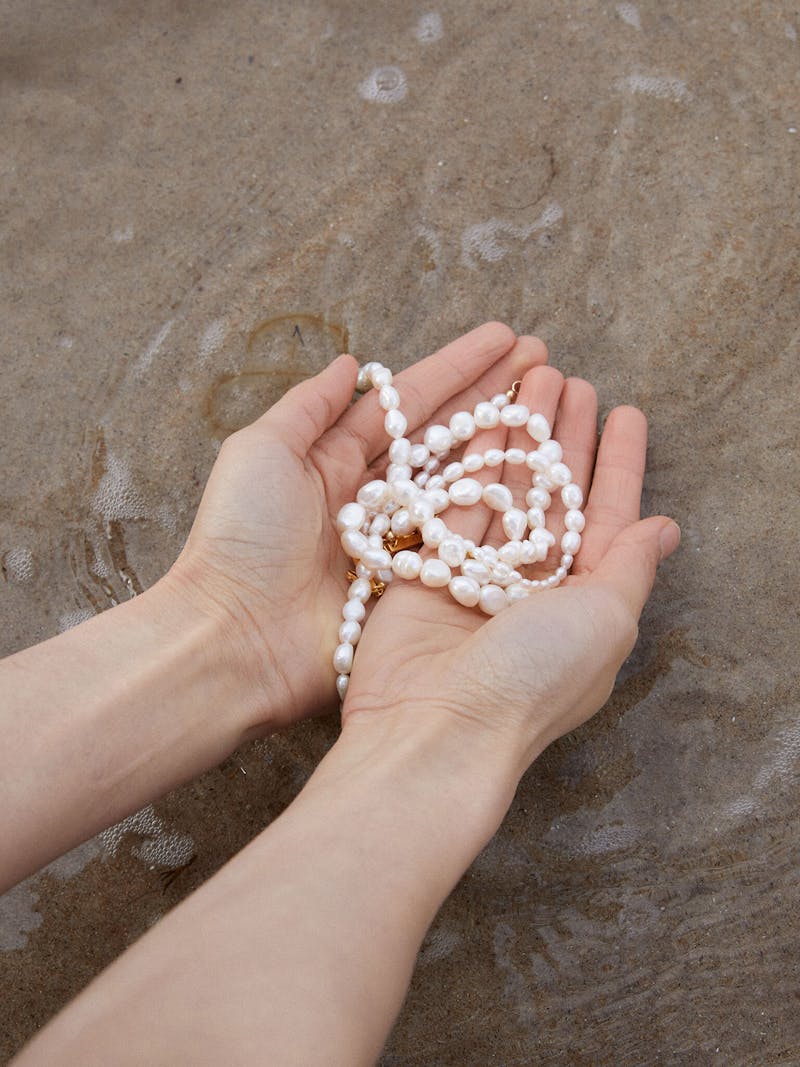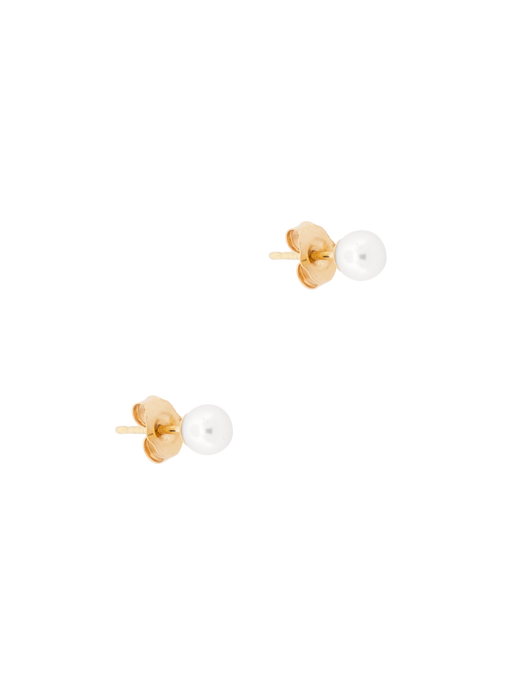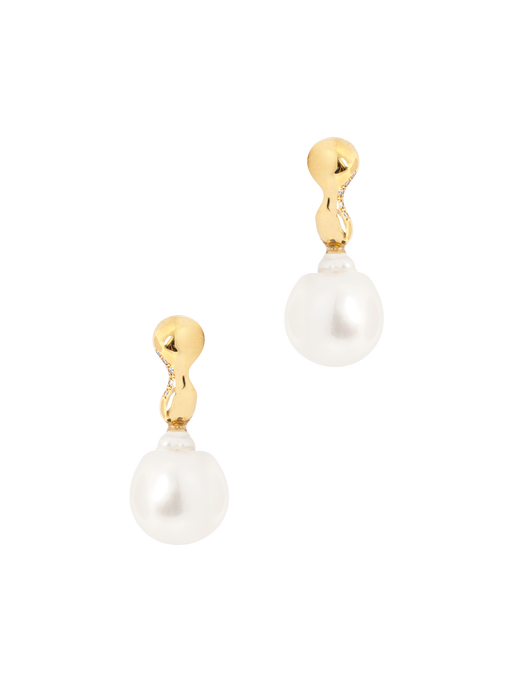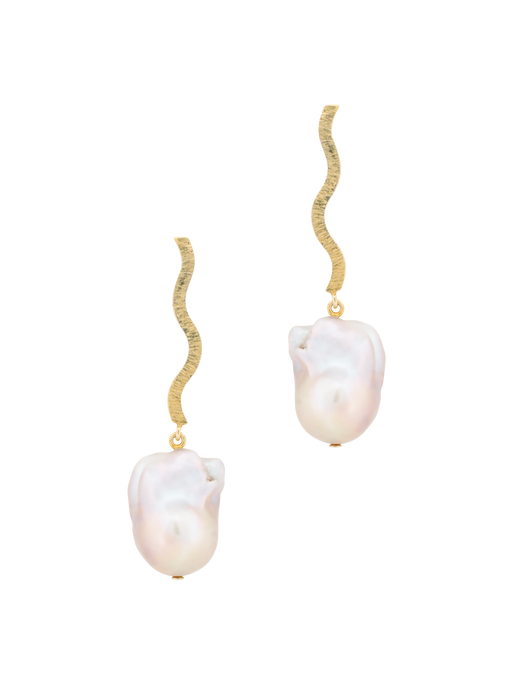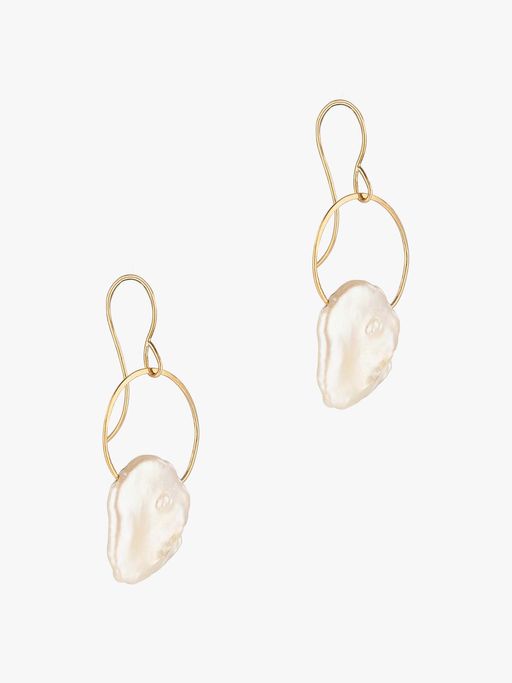What to consider when buying pearls
Where do pearls come from?
You will have come across the terms ‘natural’ and ‘cultured’ when shopping for pearl jewellery, but it isn’t always clear what these terms mean and how they affect the quality or price of pieces that feature pearls. In order to understand the difference we have to get familiar with how pearls are formed.
All pearls are the result of damage, disease or an irritant, such as sand or dust, interrupting the soft tissue of a mollusc. This is called ‘pearl nucleation’. The mollusc’s natural defences are what produce pearls by covering the irritant with mantle cells which secrete nacre. These layers of nacre are comprised of organic material and aragonite. With time layers of nacre build up and interact with light via reflection and refraction, resulting in the unique lustre and iridescence that pearls are renowned for.
Natural vs cultured pearls – How to tell the difference between natural pearls and cultured pearls?
When it comes to natural versus cultured, the difference lies in the way pearl nucleation occurs. With cultured pearls, nucleation is artificially induced whereas with natural pearls, nucleation occurs at random. Not all farmed pearls are produced in the same way with cultured pearls falling into two main categories, bead nucleated and tissue nucleated.
Bead nucleated pearls are usually farmed using saltwater molluscs like oysters, where a bead is implanted into the body of the oyster alongside a sample of nacre secreting tissue of another oyster. After two to three years layers of nacre coat the surface of the bead producing a pearl. These pearls can be referred to as Akoya, South Sea Cultured or Cultured Marine pearls.
Tissue nucleated pearls are amongst the most common types of pearls available today. This method relies on freshwater molluscs such as mussels and can produce larger quantities of pearls from each mussel. Slices of nacre secreting tissue are placed into small incisions made in the host oyster. This provides the irritation needed to start pearl growth. Pearls formed in this way are simply referred to as Cultured Freshwater pearls.
Beadless, cultured freshwater pearls are the most common type of pearl used in contemporary jewellery. The ability to farm these pearls in large quantities makes freshwater cultured pearls an affordable option for most jewellery lovers. That said, only around 1% of the freshwater pearls harvested are considered top quality, so it still remains rare to find exceptional examples of beadless cultured freshwater pearls.
The majority of pearls used in contemporary jewellery, including pieces found here at Finematter, are freshwater cultured. These White Pearl Diamond Stud Earrings by Satomi Kawakita put the spotlight on classic round pearls. It goes without saying that natural pearls will forever be amongst the most valuable, mainly due to their increasing rarity. Factors such as the occurrence of predators, climate change and ocean pollution have dramatically affected the number of pearl forming mollusks found in nature. Due to the rarity of natural pearls, it is increasingly difficult to find matching specimens thus much of natural pearl jewellery features interesting asymmetric designs.
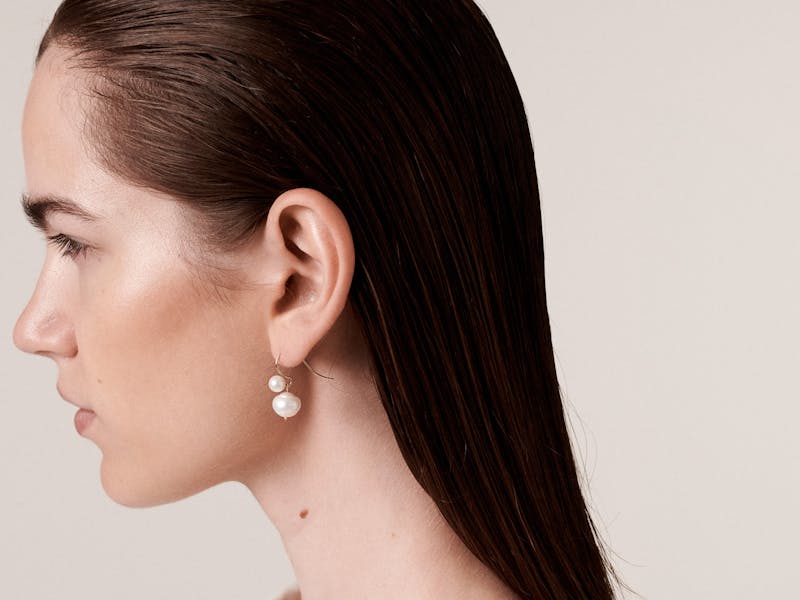
More than just round
Pearls have been a staple of jewellery boxes for centuries, historically worn by monarchs or those occupying high positions within society. It is easy to imagine perfectly spherical pearls strung together but the reality of pearls is much more fascinating. Due to a number of factors including methods of production, mollusk type and growth conditions, it is more common to find irregular shaped pearls, with over 90% of pearls not fitting into the round category.
The quality of a pearl is generally dictated by its colour, lustre, surface smoothness, size and shape. Traditionally, pearls that are rounder would command higher prices but the demand for irregular shapes has started to change the way pearls are valued. It is important to note that both natural and cultured pearls can come in a variety of shapes and sizes, like the Small Weaving Pearl Necklace by WWAKE.
Round: Perfectly round pearls are amongst the rarest shapes you can find thus making them very difficult to match when fashioning necklaces and bracelets. As a result, many pearl necklaces feature a graduated design to distract from any small inconsistencies. Cultured rounds are common especially in saltwater mollusks as a round bead is used to nucleate pearl growth. This makes it more likely that the resultant pearl will be round.
Oval: Some pearls are not quite round enough to be classified as such and are termed oval. These pearls will slightly taper at each end with a fatter, rounder centre. Traditionally the more symmetrical oval shapes would be the most sought after but designers like WWAKE have been embracing nature's imperfections and featuring slightly less perfect shapes in their jewellery, like these Irregular Pearl Earrings.
Button: Button shaped pearls are slightly to very squished rounds, with flattened tops and bottoms. This shape is often used in earrings and rings as the flat side can be easily attached to the settings.
Drop: Pearls that resemble a teardrop or pear shape are categorised as drops. The more symmetrical the pear shape, the better. Drop pearls come in a variety of sizes making them ideal for use as pendants as well as small accents in jewellery. Finematter designer Sara Jin Mi showcases drop pearls in her Dressed Diamond Pearl Earrings.
Baroque: If you’ve ever come across a pearl that seems to lack any sort of shape and is a wrinkly, wonky, beautiful mess of iridescence, then you’re probably looking at a baroque pearl. A great Finematter example is the Rita Necklace by AGMES features a string of large, iridescent, freshwater baroque pearls simply finished with a high shine silver toggle clasp. The term baroque describes any pearl that lacks symmetry or that has an abstract form.
Are pearls sustainable?
Changes in consumer habits, pushed through by younger, more environmentally conscious buyers has seen demand for pearls increase year on year which has in turn led to an increase in production of some baroque varieties. Keshi pearls were previously discarded as a byproduct of the perm farming process but are now actively cultured and sought after. Sustainable production combined with the versatility of these organic gemstones continues to make pearls a must have for all jewellery lovers.
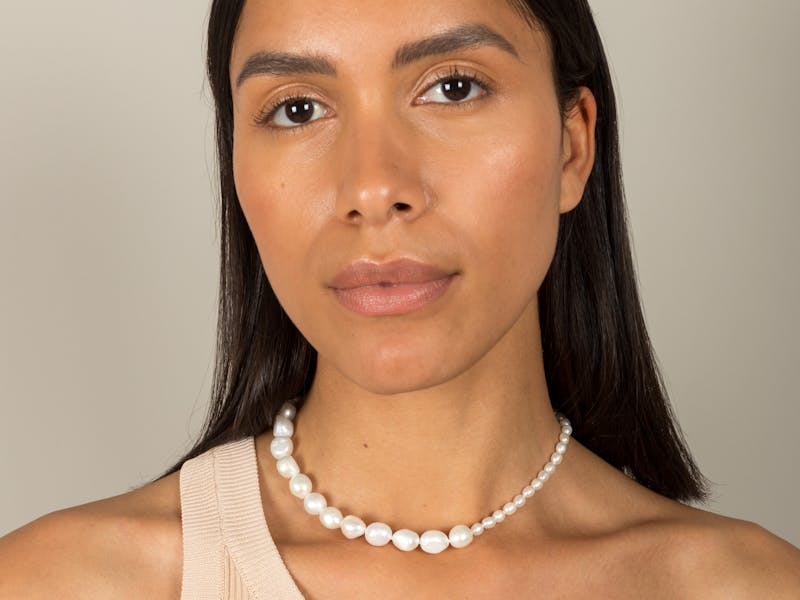
A world of colour
When thinking of pearl jewellery, it is easy to imagine strings of white, iridescent pearls, or perhaps a pair of creamy pearl drop earrings. Classic white pearls will always remain a jewellery box staple, but for those looking to add colour to their jewellery collection, pearls can be a great place to start.
The colour of a pearl is determined by a number of factors. The type of mollusc in which it was formed, the type of environment in which the mollusc is grown, the method of formation, eg. beaded cultured versus tissue cultured, and the quality of the nacre all affect the colours seen in pearls.
The first, and possibly most important factor is the type of mollusc a pearl is created in. Different species of mussel or oyster will produce different body colour variations of pearls. For example, naturally occurring grey, blue and black pearls are formed in the Indo-Pacific region within the Black Lipped Oyster, otherwise known as Tahitian Pearls. Meanwhile pink, peach and lavender pearls are formed within freshwater mussels, commonly from cultured sources in China. Gastropod pearls are distinguished by their colour, from striking orange Melo Pearls formed by marine snails, to the ceramic pink hues of Conch Pearls.
The thickness of each individual layer of nacre combined with the number of layers dictates the depth of colour in a pearl. A pink pearl with numerous, thick layers of nacre will result in a deep, saturated tone whereas a pearl with thinner, fewer layers will appear pale in comparison.
The quality of a pearl’s nacre affects not only the overall body colour but also any overtones or iridescence. The spectral colours seen and the mirror-like lustre seen in the highest quality pearls is caused by the refraction and reflection of light waves. As light penetrates the pearl’s surface, the rays bounce off of individual layers of nacre, creating an optical effect that is strengthened with the amount of nacre layers present.
The variety of body and overtone colour combinations is endless with very few pearls being almost identical. When it comes to choosing coloured pearl jewellery, finding pieces that complement your existing collection is always a great place to start. For those who prefer classic looking pearls, combining white pearls with other coloured stones like in this Sherbert Necklace is a stylish alternative.
Pearl facts
1. Gastropods such as marine snails, abalone and giant conches also produce pearls
2. Conch pearls are among the rarest organic gemstones, and are characterised by their pink colour and the distinct flame-like pattern seen on their surface
3. Abalone pearls are known for their abstract forms and bright iridescent colours. Naturally formed abalone pearls, also known as paua shells, are incredibly rare to find but they can be cultured.
4. Melo pearls are created by sea snails and are identified by their vibrant orange colour and flame-like textures.
5. The types of pearls formed in gastropods are almost entirely calcite and are referred to as non-nacreous pearls. This separates them from the pearlescent nacreous pearls found in molluscs.
6. Despite being the lesser known variety of pearl, non-nacreous pearls are some of the largest pearls ever discovered.
7. The second biggest pearl found was the The Pearl of Lao Tzu, later named the Pearl of Allah. The 31,893ct baroque, white pearl was revealed in 1934 in the Philippines.
Cleopatra's $500,000 dinner
This story was recalled by Pliny the Elder and refers to a bet made between Mark Anthony and Cleopatra. According to Pliny, Cleopatra “owned the two largest pearls of all time, left to her by oriental kings”. Anthony would occupy himself by feasting on extravagant foods and rare delicacies - none of which impressed Cleopatra who saw his indulgence as cheap attempts at luxury and opulence.
In retaliation, Cleopatra wagered that she could top any feast of Anthony’s, promising to spend 10,000,000 sesterces, around $500,000, in one dinner. Anthony didn’t believe that she could back up such a claim but was eager to see what Cleopatra would come up with. The next day, Cleopatra presented Anthony with a feast fit for a king but that said he was not entirely impressed. When questioned, Cleopatra reassured him that the best was yet to come. With that, she orders dessert to be served. A dish of vinegar was placed in front of Cleopatra who was wearing a large, stunning set of natural pearl earrings. With a swift movement, she removed one pearl earring, soaked it in the vinegar until it dissolved, and then downed the remaining liquid. Naturally the bet was overseen by a third party, in this instance Lucius Plancus, who immediately prevented Cleopatra from consuming the remaining earring and immediately declared Anthony as the loser.
The remaining pearl was cut in half and put on display in the Pantheon, placed in each ear of the statue of Venus.
 Earn Credit
Earn Credit